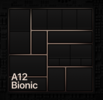Apple A10X Fusion vs Apple A16 Bionic vs Apple A12 Bionic
Apple A10X Fusion
► remove from comparisonThe Apple A10X Fusion is a system on a chip (SoC) from Apple that is built into the 2017 iPad Pro models. It integrates six 64 Bit cores that are divided in two clusters. Three high performance cores are clocked at up to 2.39 GHz. The three power saving cores are used for non demanding tasks. It looks like only one of both clusters is able to run at a time (therefore the apps see only three cores). The principle is similar to the first generation of ARMs big.LITTLE concept.
The performance of the SoC is positioned in the high and and clearly faster than all previous Apple SoCs. Even compared to Android high-end SoCs like the Snapdragon 835, the A10X takes the lead (e.g. in Geekbench or Antutu).
The integrated graphics card of the SoC will most likely stem from PowerVR (again) and features 12 cores instead of 6 in the A10 SoC.
According to TechInsights, the A10X is manufactured in the brand new 10 nm FinFet process at TSMC. Altough it offers more function blocks, the A10X is with measured 96.4 mm2 significantly smaller than the previous A9X (143.9 mm2).
Apple A16 Bionic
► remove from comparison
The Apple A16 Bionic is a System on a Chip (SoC) from Apple that is found in the iPhone 14 Pro (2022) models. It offers 6 cores divided in two performance cores (codename Everest, up to 3.46 GHz) and four power-efficiency cores (codename Sawtooth, up to 2.02). According to Apple, the most improvements were made to the efficiency cores and the improved memory bandwidth (+50% thanks to LPDDR5). According to the die analysis from angstronomics, the e-core cluster still has the same 4 MB L2 cache, but the p-cores now offer 16 MB L2 cache. The SLC (System Level Cache) however seems to be reduced to 24 MB.
The Neural Engine still offers 16 cores and offers an increased performance of 17 TOPS (vs. 15.8 of the A15) for AI tasks. The integrated graphics engine still offers 5 cores and benefits mostly from the higher memory bandwidth. The new display engine supports adaptive refresh rates down to 1 Hz, the new always-on display, and improved anti-aliasing (for the dynamic island animations).
The CPU performance only shows small improvements to the last generation (Apple A15 Bionic). Still, the A16 is by far the fastest mobile CPU for smartphones and leaves e.g. the Snapdragon 8+ Gen 1 easily behind (in Geekbench 5.4 single- and multi-thread tests).
The chip is manufactured on the modern 4nm process at TSMC and integrates nearly 16 billion transistors (compared to the 15.8 billion of the A15 and 11.8 of the A14). Apple emphasized on efficiency and e.g. mentioned 20% power savings for the big performance cores and class-leading efficiency of the e-cores.
Apple A12 Bionic
► remove from comparison
The Apple A12 Bionic is a System on a Chip (SoC) from Apple that is found in the iPhone Xs and Xr. It was announced late 2018 and offers 6 cores divided in 2 performance cores and four power efficiency cores. Compared to the previous A11 Bionic, the A12 should offer a 15% improved CPU performance for the performance cores and a 50% lower power consumption for the efficiency cores (both according to Apple).
The chip also includes a new GPU that is advertised as 50% faster, the M12 Motion co-processor and a Neural Engine with 8 cores for up to 5 trillion operations per second.
With 6.9 billion transistors, the A12 Bionic is a big chip especially compared to the Snapdragon 835 (3 Billion) or a Skylake desktop quad-core Soc (1.75 Billion). Compared to the A11, the A12 integrates 60% more transistors.
| Model | Apple A10X Fusion | Apple A16 Bionic | Apple A12 Bionic | ||||||||||||||||||||||||
| Codename | Cyclone 4? | Crete | |||||||||||||||||||||||||
| Series | Apple Apple A-Series | Apple Apple A-Series | Apple Apple A-Series | ||||||||||||||||||||||||
| Clock | 2390 MHz | 2020 - 3460 MHz | <=2490 MHz | ||||||||||||||||||||||||
| Cores / Threads | 6 / 3 | 6 / 6 | 6 / 6 | ||||||||||||||||||||||||
| Transistors | 3300 Million | 16000 Million | 6900 Million | ||||||||||||||||||||||||
| Technology | 10 nm | 4 nm | 7 nm | ||||||||||||||||||||||||
| Features | ARMv8 Instruction Set | ARMv8 Instruction Set, Machine Learning Controller, 16-Core Neural Engine, Secure Enclave, Advanced Image Signal Processor | ARMv8 Instruction Set | ||||||||||||||||||||||||
| iGPU | Apple A10X Fusion GPU / PowerVR | Apple A16 GPU 5-Core | Apple A12 Bionic GPU | ||||||||||||||||||||||||
| Architecture | ARM | ARM | ARM | ||||||||||||||||||||||||
| Announced | |||||||||||||||||||||||||||
| L2 Cache | 20 MB | 8 MB | |||||||||||||||||||||||||
| L3 Cache | 24 MB | ||||||||||||||||||||||||||
| Series: Apple A-Series |
| ||||||||||||||||||||||||||
| L1 Cache | 256 KB |
Benchmarks
Average Benchmarks Apple A10X Fusion → 100% n=7
Average Benchmarks Apple A16 Bionic → 209% n=7
Average Benchmarks Apple A12 Bionic → 198% n=7
* Smaller numbers mean a higher performance
1 This benchmark is not used for the average calculation












